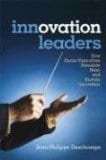By: Chuck Frey
In his new book, Innovation Leaders: How Senior Executives Stimulate, Steer and Sustain Innovation, Jean-Philippe Deschamps explains that innovation leaders are unique and rare individuals who must possess a unique set of seemingly opposed characteristics.
In his new book, Innovation Leaders: How Senior Executives Stimulate, Steer and Sustain Innovation, Jean-Philippe Deschamps explains that innovation leaders are unique and rare individuals who must possess a unique set of seemingly opposed characteristics. Perhaps that’s why successful innovation leaders are such a rare breed. Here are six attributes that he has identified that sets innovation leaders apart:
1. A mix of emotions and realism: Innovation leaders must embody the ability to think creatively and envision new products, services and markets at the front end of the innovation process, and yet be pragmatic and process focused on the backend (the implementation end) of innovation.
2. The acceptance of uncertainty, risks and failures, coupled with an urge to make their staff learn from them: The author cites acceptance of risk and tolerance of failure are among the top attributes of innovation leaders. Leaders must not only foster a culture where failure is tolerated, but where learning needs to take place after each failure, so executives can avoid the same problem next time around. “The whole point of the ‘first mover’ advantage, so cherished by venture capitalists, is the opportunity to gain a ‘first learner’ advantage.”
3. A high degree of passion for their mission and for innovation, as well as the burning desire to share that passion with their staff: “All innovation leaders have one thing in common – a high level of energy and an almost innate ability to communicate it to their staff.” Managers may be passionate about their customers, about their “bet the company” projects or simply about winning in the market.
4. The willingness to proactively search for external technologies and ideas, and then to experiment with them: Business and technology leaders are increasingly aware of the need to tap all possible sources of technologies and ideas, both internally and externally. But in many traditional, mature industries, companies still rely on their internal resources for the bulk of their development activities. The “not invented here” syndrome is unfortunately all too real in many corporate R&D departments. Scientists and engineers tend to instinctively resist outsourcing tasks they believe they could handle if they were given the chance.
5. The courage to stop projects, not just start them, and the flair to decide when to persist versus when to pull the plug: Innovation leaders have responsibility for the effective use of their company’s resources. That’s why they must occasionally be “hatchet people,” killing projects that don’t appear to be bearing fruit. Often, they must rely on gut feel to decide which projects may eventually be successful versus those that are destined to become cash hogs, with little to show in return. This role requires consummate interpersonal skills, because scientists, engineers, product managers and others responsible for new product development sometimes become emotionally attached to their “pet” projects and may need help making a dispassionate decision about the future of their “baby.”
6. A talent for building and steering winning teams, and a knack for attracting and retaining innovators: Innovation leaders play a critical role in assembling teams. Innovation is definitely a team effort, and that’s why they focus considerable time and attention on this area.
Although I am only a few chapters into this book, I am already finding it to be quite intriguing. While most innovation books focus on how to create innovative cultures, processes and mindsets, this is the first book that I have seen that delves into the critical area of innovation leadership. What’s refreshing, too, is that Deschamps resists the temptation to be prescriptive in his writing (“Do these eight things and you will be successful!”). Instead, he acknowledges that every company is different, and therefore the approach to innovation leadership must be approached differently.
This book should definitely be on your innovation reading list.

